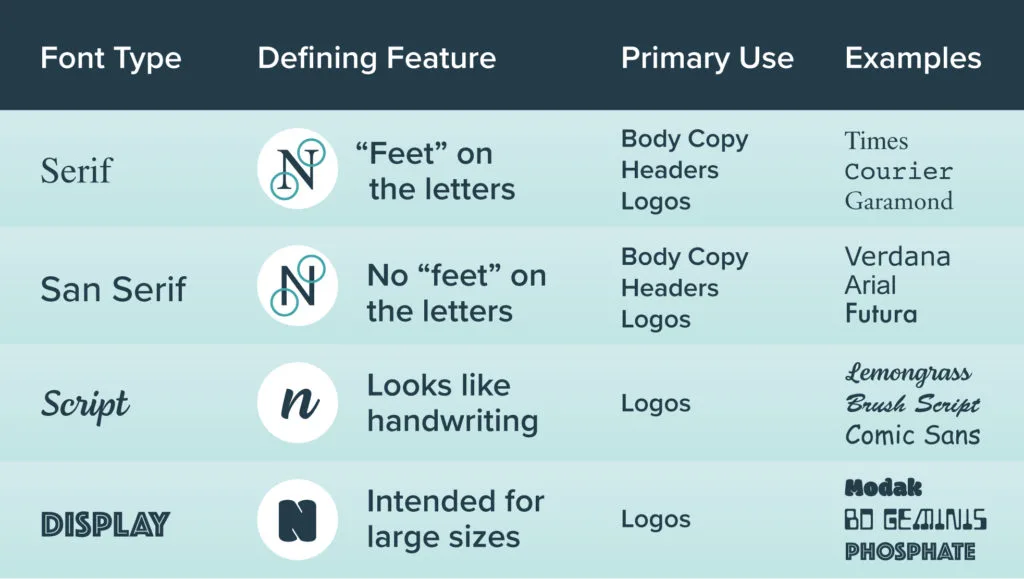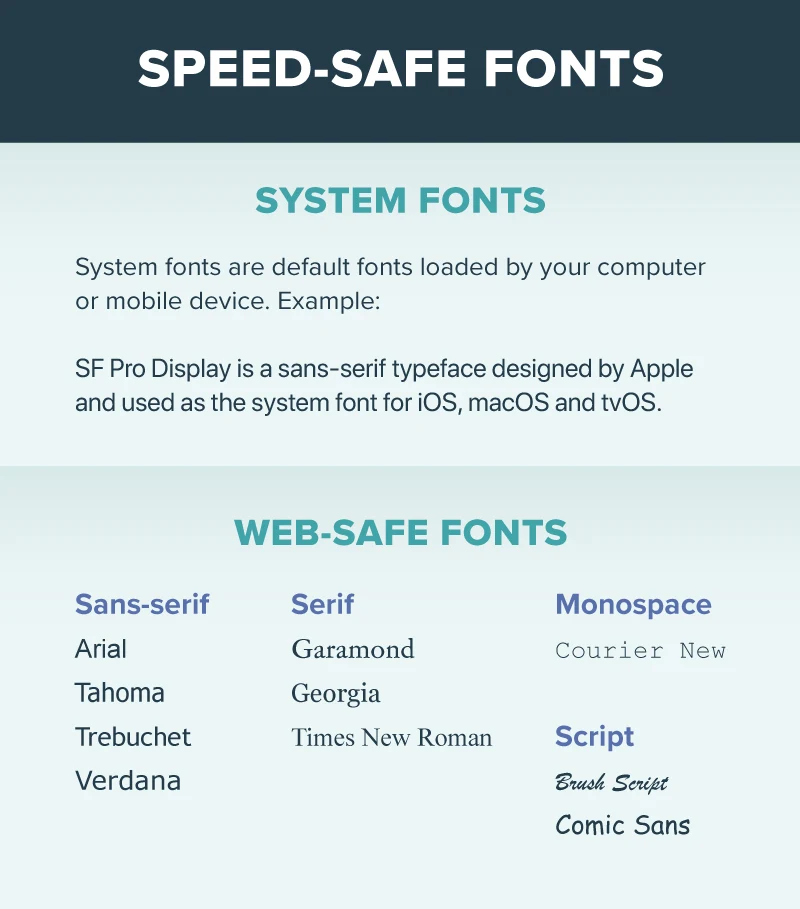How to Choose Fonts for Site Speed and Accessibility


Call me a typography nerd, but choosing brand fonts is always my favorite part of the design process.
Typography, the study of fonts and the way letters are designed has long been pivotal in providing readers with easy reading experiences.
(Okay, yes, I am a typography nerd.)
I always recommend hiring a designer if you can afford one, even if just for your logo. If you’re in a situation where you have to choose a font, here are the most basic categories of fonts to choose from:

When designing your website or brand, it’s a good idea to stick to only a few fonts. For example, at Mediavine, our brand consists of two fonts (a serif and a sans serif), which we use on everything we make. We will pull out other fonts for emphasis only on special occasions, such as a social post or an event logo.
Utilizing the different weights of your typeface is a good way to provide variety without overdoing it. Weights are the various thicknesses available within a typeface, such as thin, light, Roman, bold, extra bold, etc.
Back in the letterpress days, typesetters chose individual typefaces and letters and manually spaced them out to best suit the reader and the final output. Now, we can code these choices right into our websites, but many of the same best practices still abide.
Website accessibility is a big talking point these days, and for good reason: What’s the point of publishing all that wonderful content if a percentage of readers can’t see it?
For people with any kind of visual impairments, making sure all the text on your site is readable and legible is a huge part of being a good internet citizen. Here are a few tips:
Unfortunately for designers who could nerd out about fonts for hours, fonts aren’t always the best for pagespeed. And what do users, search engines and social media sites all care about?
Alas, fonts are an area of your brand that you may end up compromising for the sake of speed.
But you do have a few options when it comes to this compromise:
Web-safe fonts are the fastest option because the browser and website aren’t loading any extra files. This can be accomplished via some quick CSS or, if you’re using Trellis, in the Trellis settings.
This is the method we use on our owned-and-operated site, The Hollywood Gossip, which we mention in our case study on how The Hollywood Gossip passed Core Web Vitals.
This option is the easiest to set up and guarantees the fastest and least disruptive method for loading fonts. Tahoma and Garamond make for a good sans-serif and serif combination while providing a break from the Arial + Times combo.
With this approach, you can load the fonts into your theme directly, but there is a chance for some slowdown. Chrome and other browsers introduced font fallbacks, but when that fallback font is swapped with your Google Font, cumulative layout shift can occur.
No bueno.
If the choice between using a Content Delivery Network (CDN) and hosting a font itself comes down to pagespeed, self-hosting the font will win every time. The arguments in favor of a CDN have diminished over the past several years. The discussion point of “is any time saved by a CDN?” is lost to the time it takes to send a CDN a request.
This method is a bit more technical, so I’m going to let our Product team take this one:
By default, Trellis uses ‘font-display: optional’. Using ‘optional’ provides the best balance of preventing CLS while still allowing for non-web-safe fonts.
It can be a bit tricky to explain, but the gist of it is that the browser is doing some multi-tasking to quickly download and serve a requested font before any text is able to be shown on a given page. The browser is actually pretty good at doing this in less than 100ms, and most users will see the custom font on their first visit and on every visit thereafter. If the browser couldn’t have the font loaded in time, users will see a web-safe font until they move to a different page. It’s this latter point that prevents CLS.
Other ‘font-display’ options are available. Of those, ‘font-display: fallback’ is noteworthy for ensuring that if a font is loaded quickly enough the browser may switch the font shown on the page to the requested one, provided it is ready in less than 3 seconds. This creates a more pleasant experience for a visually fine-tuned website but introduces the risk for CLS on slow connections.
You can install a font through a service like Google Fonts or Adobe Fonts, but it also means your website can’t show any text until that font loads, so do so at your own risk of not passing Core Web Vitals.
This is definitely our least favorite option.

Believe me, it hurts my designer soul that some of my favorite fonts aren’t available as web-safe fonts. And it begs the question, why would Google provide web fonts and then ding us for using them?
But I have faith that the industry will catch up and give us more choices — eventually. In fact, there are new browser capabilities in development that will provide more options to balance performance and font selection.
My favorite part of being a designer is coming up with creative solutions to difficult problems, so I say there’s still a way you can maintain a branded look without compromising speed:
Incorporate the non-web-safe font of your choice into your logo or any images you have on your website while still using a web-safe font for text.
Use your favorite design tool to make branded images with the fonts of your choosing, all while keeping your site speed-focused with web-safe fonts.
And don’t fret — much to any designer’s chagrin, probably no one but you will notice that you make changes to your typefaces. Web-safe fonts are so ubiquitous, most people won’t think twice about seeing them.
Stay up to date with the latest from Mediavine
Publishers spend time creating great content that keeps readers coming back, and we know that safeguarding that content and maintaining control over how it’s used are critical concerns in today’s …
 Eric Hochberger
Eric Hochberger
In a blog post last week, Google announced plans to launch generative AI into Search Labs with a new product called Search Generative Experience (SGE). What exactly is SGE, and …
Since ChatGPT’s release in November 2022, OpenAI’s prototype of generative AI — that is, artificial intelligence that can produce new content on demand — has dominated popular tech media. We’ve …